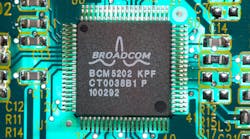In 2013, Broadcom acquired LSI Corporation for $6.6 billion. In 2015, the company, when it was still called Avago Technologies, spent $37 billion on Broadcom and commandeered the name after the acquisition closed. In 2017, it was Brocade Communications, which Broadcom bought with $5.5 billion.
But Hock Tan, the company’s 66-year-old chief executive, could never close its $117 billion deal for Qualcomm. This month, President Donald Trump signed an order that forced Broadcom to abandon the potential deal because it could hurt Qualcomm’s research and development and therefore hurt American leadership in 5G technology.
The company’s chief financial officer Thomas Krause recently said that Broadcom would continue striking the same types of deals that have built it into one of the giants of the $400 billion semiconductor industry. He also reiterated the company’s plans to relocate in the United States to take advantage of recently lowered corporate tax rate.
“We do see potential targets that are consistent with our proven business model and that also can drive returns well in excess of what we would otherwise achieve buying our own stock or paying down debt,” Krause said in a recent conference call to discuss Broadcom’s first quarter financial results.
The strategy is one of the most significant ways that Broadcom is returning to normal after Qualcomm escaped its hostile takeover. Broadcom typically targets companies with high profit margins in markets with little competition, wrote William Stein, an analyst with SunTrust Robinson Humphrey, according to Barron's. It was willing to stretch that formula to buy Qualcomm.
For months, Broadcom maintained that it could maneuver the San Diego, California-based company out of its battles with regulators worldwide and customers, including Apple, that had refused to pay licensing fees on Qualcomm’s patents. “Qualcomm was clearly a unique and very large acquisition opportunity,” said Krause.
“Given the maturity of the industry, the consolidation it has seen, and our relative size now, our future acquisitions are much more likely to be funded with cash available on our balance sheet” instead of using loans, Krause said. Relocating to the U.S. should smooth out potential deals, wrote Stacey Rasgon, an analyst with Bernstein Research, according to Barron's.
Many industry analysts say that San Jose, California-based Xilinx could be on the chopping block. The company has a market capitalization of about $18.4 billion and charges almost 70 percent more for FPGAs than it costs to manufacture them. These chips can be programmed as accelerators, storage and networking in servers as well as cars and factory equipment.
Other analysts highlighted Mellanox, which manufactures switches and networking equipment for data centers using Infiniband and Ethernet. The firm, valued at $3.8 billion and based in Sunnyvale, California, would fit with Broadcom’s storage and networking businesses, recently bolstered with its $5.5 billion deal for Brocade.
Mellanox would be less expensive than Xilinx, and its shareholders would likely push for a buyout. The company has been brawling with shareholders over the composition of its board for months. The trouble started when it admitted to refusing to listen to an offer from Marvell, which shelled out $6 billion for its rival Cavium instead.
But industry analysts also left the door open to Broadcom targeting larger companies than Mellanox and Xilinx, which reported $864 million and $2.35 billion in revenue last year, respectively. Potential targets could include Marvell and Advanced Micro Devices, both of which generate more than $5 billion annually.
Angelo Zino, an analyst with CFRA Research, told the Wall Street Journal that other potential targets include Cypress Semiconductor, Integrated Device Technology and ON Semiconductor. Maxim Integrated, which manufactures analog chips for cars, manufacturing and connected devices, could also work if Broadcom is willing to change strategy slightly.
That Broadcom could raise $100 billion in loans from banks and investment firms, including Silver Lake Partners and Kohlberg Kravis Roberts, to acquire Qualcomm shows that almost anything is possible with the Wall Street heartthrob. Qualcomm generated $22.3 billion in revenue last year, about $5 billion more than Broadcom.
Broadcom is also trying to appease shareholders. Krause said that the company would pay shareholders half of its free cash flow in the form of dividends. Broadcom defines free cash flow as income minus capital expenditures, and the company amassed $1.5 billion of it in the first quarter or about 27.5 percent of revenue.
“The allocation of the remaining 50 percent of free cash flow is governed by the returns that we believe we can drive via acquisition,” said Krause. This month, Broadcom reported first quarter revenues of $5.33 billion, up 10 percent from the previous quarter and 29 percent from the same span last year. The company forecast $5 billion in revenue for the second quarter.








